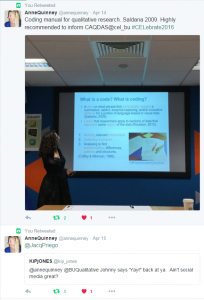I delivered this workshop as part of #CELebrate2016, with three main objectives. First, to acquaint participants with the principles of using Computer Assisted Qualitative Data Analysis Software (CAQDAS) for qualitative analysis; second, to discuss the rewards that come with introducing students to the potential uses of CAQDAS while they are learning qualitative analysis techniques; and third, to suggest some practical points to consider before/during our students’ and our own engagement with CAQDAS.
I introduced the basic and more advanced features of CAQDAS, relating key functions such as coding and retrieval with their ‘old school’ manual equivalent. I went on to introduce and briefly compare the interfaces of two popular packages: MAXQDA12 and NVivo10. In doing so, I also considered the current debates and work being carried out in the UK and internationally in relation to CAQDAS teaching. I mentioned, for example the Pedagogy of Methodological Learning project (NCRM, University of Southampton), as well as the longstanding work of other academics working with CAQDAS in higher education and beyond (e.g. Bazeley & Jackson, 2013; Kuckartz, 2014; Paulus & Bennett, 2015; Silver & Lewins, 2014).
I then focused on some commonly asked questions, such as 1) whether CAQDAS ‘condition’ how students analyse their data; 2) the problem of ‘segmentation’ of data when using CAQDAS; 3) the extent to which students using CAQDAS rely on the quantification of qualitative data for their analysis; 4) the differences between CAQDAS and linguistics-driven software such as Alceste, EVOQ and Leximancer.
I finalised by  explaining my five-step ‘self-help’ approach for the busy academic or graduate student, based on my teaching experience:
explaining my five-step ‘self-help’ approach for the busy academic or graduate student, based on my teaching experience:
- Master your analytical technique (thematic analysis, qualitative content analysis, framework analysis, narrative analysis) beforehand – and master it manually
- Familiarise yourself with the basic features of the software(s) in question
- Think about the final product – what you want to achieve – and delve into advanced features of the software to cater for those needs
- Consider giving ‘movement’ to your data – avoid tautological analysis
- Keep learning and look for other suggestions (e.g. Silver & Woolf, 2015)
One more thing…just to prove the power of social media and in relation to the last point, on being proactive about our learning…As in all my CAQDAS workshops, I suggested, “if you can only afford one textbook on qualitative analysis, make it Johnny Saldaña’s The coding manual for qualitative researchers, which is flexible enough to inform a variety of approaches”. A Twitter conversation ensued, as can be seen on the picture.
Dr Jacqueline Priego is a Research Fellow at Bournemouth University’s Centre for Excellence in Learning, an Associate Member of the Centre for Qualitative Research, and a MAXQDA Professional Trainer. Jacqueline has been teaching CAQDAS since 2010. Her presentation slides are available on request @jacqpriego









Hi Jacqueline – thanks for this. I love your 5 step ‘self help’ approach – especially no. 4… thinking about the final product. If you know what kinds of questions you want to ask of your data – then setting-up your project in a product like NVivo becomes much easier and more efficient.
Thanks a lot, Kathleen. The point was effectively to avoid the ‘illusion of choice’ (Freire) that technology sometimes seems to give. Analysis becomes easier and efficient, as you say, if we/our students think about the final product, and weight the (dis)advantages of the time our students will invest in learning a software. And thanks for NVivo support and follow up on Twitter!